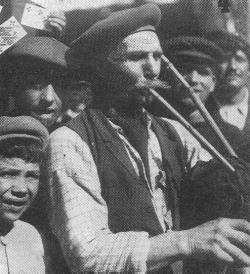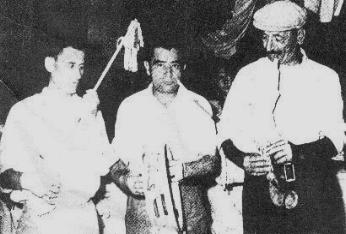The feast of Saints Peter and Paul on June 29th marks in important event in the calendar of Maltese popular customs and festivities. Traditionally known as "l-Imnarja', it goes back further to even before the coming of the Knights in 1530 and is essentially a country folk-festival. Following closely the hard toils of harvest time, it made a pleasant break in the dull everyday routine that made up the peasant's life in the past: - a few crowded hours of merrymaking and rustic song, amidst a yearly routine of sweat and toil working the land.
The name 'L-Imarja' is a corruption of Italian 'luminaria' - illumination. Meant a Festival of Light It a festival of light, recalling tile illumination of the Mdina cathedral, the city walls of the old capital, and of other rural parts with lights, as a sign of rejoicing on June 28th and 29th.
It is traditionally held that country girls used to stipulate with their intended husbands that they should take them once a year to the principal feasts of the island, i.e. the feast of 'l-Imnarja' and that of St. Gregory. The women appeared at the Gardens of Buskett in their wedding dress, irrespective of the season in which they were married.
Here and there one could see gowns of velvet and fine silk together with bodices of rich material and underskirts Of homespun cloth as recorded by the French Knight F.E. De Guignard, Comte de Saint Priest, in 1791. Fashions have now changed, and no newly married bride would dream of going to Buskett in her wedding dress. Still the many people who gather there today are no less colourful and cheerful.
IL-BANDU
 On the weekend closest to St. John's Day, celebrated on June 24th, a feast-day formerly also associated with the lighting of bonfires - it is customary to herald the holding of 'I-Imnarja' by means of a simple ceremony known as 'Il-Bandu'. The word 'Bandu' means a proclamation issued for the good order of the people and was formerly read by the town-crier, 'Il-Banditore', who announced its contents at certain specified places of the old city.
On the weekend closest to St. John's Day, celebrated on June 24th, a feast-day formerly also associated with the lighting of bonfires - it is customary to herald the holding of 'I-Imnarja' by means of a simple ceremony known as 'Il-Bandu'. The word 'Bandu' means a proclamation issued for the good order of the people and was formerly read by the town-crier, 'Il-Banditore', who announced its contents at certain specified places of the old city.
This custom was revived, with certain changes, some years ago on the initiative of the 'Casino Notabile' and of the local Agrarian Society who also organise the yearly Agricultural Show held on the eve of the feast, and the morning, of June 29th at Buskett Gardens.
Nowadays, the 'Bandu' procession starts from the Mdina Town Hall, known as the 'Banca Giuratale', with a number of "boy scouts', preceded by flute and drum and accompanied by members of the Organising Committee, who carry and display the 'palji', or prizes, that are distributed after tile horse races on June 29th.
The procession passes through the principal street of Mdina and moves on to Rabat before it returns and stops in front of St. Paul's niche in Saqajja Square, where the blessing of the palji takes place.
THE EVE OF THE FEAST
On the eve of the feast the scene shifts to Buskett Gardens, a wooded Park in the outskirts of Rabat. Here the cries of food and drink vendors mingle with the boisterous crowd. By this time the Agricultural Show would have been blessed and declared open and visitors flock to watch the display of animals, vegetables, fruits, poultry, honey, local and many other exhibits.
As the shades of evening fall slowly on the enchanting valley surmounted by Verdala Castle country-folk and other merrymakers seek out trees where they intend to spend the night beneath a flurry of leafy branches.
Even today, from all parts of Malta, people still make their way to Buskett, where the scene is set for a feast of song and food beneath the trees. The appetising smell of fried rabbit entices the merrymakers to indulge in a good feed washed down with wine from the local vats. The night is then spent in good-humoured mirth and fun, while revellers compete in singing bouts to the strains of Spanish guitars and the popular hands from the various villages.
'L-IMNARJA'- ON THE DAY
 On the afternoon of the 29th the 'Imnarja' festivities reach their climax with the traditional horse and donkey races held in the vicinity of Mdina. Long before the appointed time the' racecourse is lined with throngs of people who defy the scorching rays of the June sun to get a good view of the races.
On the afternoon of the 29th the 'Imnarja' festivities reach their climax with the traditional horse and donkey races held in the vicinity of Mdina. Long before the appointed time the' racecourse is lined with throngs of people who defy the scorching rays of the June sun to get a good view of the races.
A characteristic of traditional horse races in Malta is that animals are ridden barebacked, the jockeys gripping their mount with the knees and urging on the beasts with short sticks in either hand. In the 17th and 18th centuries these races generally, comprised seven events i.e. races for boys, negro slaves, men, donkeys, mules, mares and horses, With the abolition of slavery by Napoleon in 1798 the event for negroes came to an end, and since the middle of the 18th century the races for men and boys have been held in Imdina on the occasion of the feast of Our Lady Of Mount Carmel, observed on the third Sunday of July.
For about three centuries the loggia overlooking the traditional racecourse at the foot of 'Saqajja' has served for the distribution of the 'palji'. A Latin motto inscribed on the wall reads as follows: "Cuicumque Legitime Certaverit -1696", which may be freely translated as "for all who lawfully strive to win."
After the races, the crowds disperse and return to their homesteads by car, by bus or as was the case in the past by the traditional horse-driven cart. This event brings to a close this yearly summer folk - festival amidst the lingering joyful shouts and carefree songs of the merrymakers.

